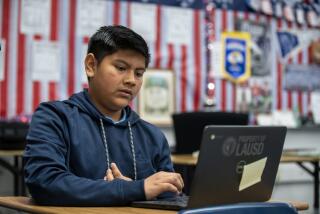Artfully Improving Education
- Share via
When public schools show big gains on standardized test scores, administrators often credit more time spent on the Three Rs.
But more time spent singing, dancing and acting might have been just as effective. Those activities can drive up test scores, too, according to research and the experience of a small private school in Fullerton.
While public schools stretch classroom reading time and pile on math problems with an eye to improving their Stanford 9 scores, the Berkeley School for Academics and the Arts practically ignores standardized tests.
But the arts, axed during financial hard times at most public schools, are thriving at Berkeley, where students’ visual art covers every inch of wall space and every morning begins with 30 minutes of aerobic dance.
Researchers tracking 25,000 students nationwide over a 10-year period began releasing data in 1997 that showed that students involved in the arts do better in school than those who aren’t involved.
Among 10th-graders, for example, 47.5% of students with low involvement in the arts scored in the top half of standardized tests, while 65.7% of those with high arts involvement scored above the test median, according to a study by the Imagination Project at UCLA Graduate School of Education and Information Studies.
The Berkeley school is very small, with 38 children in kindergarten through sixth grade. The students, who are taught in classes that combine two or three grades, get 1 1/2 hours of art, 1 1/2 hours of music and 2 1/2 hours of dance each week. They put on three shows a year, including a Shakespearean production. Last spring it was “The Taming of the Shrew.” Students are currently working on “Winter Sing,” a musical scheduled for Dec. 15.
“We are certainly committed to a strong academic program, as well,” said Korla Childress, who founded the school with co-director Lynn Costello in 1976.
“And the children do learn to read and write and calculate, but the arts, we think, are just as important.”
Berkeley, like other private schools, isn’t required to administer the Stanford 9 test the state uses to hold public schools accountable for student learning. But to provide practice on timed tests, the school gives students the Iowa Test of Basic Skills.
A 10-year average of Berkeley scores puts it close to the 98th percentile, Costello said. The average student was in the 90th percentile. Generally, students score one to two grade levels above average, she said.
The high test scores, the school directors believe, result from a combination of a strong arts curriculum and the individualized instruction students get in small classes.
Students who consistently act in plays and musicals, join drama clubs or take acting lessons showed gains in reading proficiency, self-concept and motivation, the UCLA study found. By 12th grade, those consistently involved with instrumental music scored significantly higher on math tests. The findings held true for students regardless of parents’ income, occupations or levels of education, researchers said.
Another study, which evaluated Chicago arts partnerships in inner-city schools, found that after a push for improvement, test scores went up throughout the district, but at schools with arts-integrated programs, “test score increases were even greater,” said Lynn Waldorf, managing director of the Imagination Project. Both studies were part of a report compiling seven major studies on learning and the arts. “Champions of Change--the Impact of the Arts on Learning” was sponsored by the GE Fund and the John D. and Catherine T. MacArthur Foundation.
“What happens with the arts is that it increases children’s motivation and gets them excited about the work,” Waldorf said. “It strengthens creative and critical thinking skills.”
Childress and Costello weren’t surprised by the news.
“We knew that from our own school experiences. We knew how important it was to include the arts in the day,” Childress said. “Some students die on the vine without it.”
At Berkeley, there are students with a wide range of abilities, including some with mild learning disabilities, some who are “happy, fairly average” students and some who are truly gifted youngsters, she said.
Students with a flair for the arts are drawn to the school, but parents are equally pleased to discover that grammar, phonics and geography are part of the curriculum.
Lu Scannell enrolled her son at Berkeley for the combination pre-kindergarten/first-grade class and the individual attention.
“He loves it. He doesn’t want to go home at the end of the day,” she said of her third-grader.
Scannell’s son seems drawn to the school’s arts emphasis. But what about the art-challenged?
“There are some who feel uncomfortable with it at first, but by the end of their years here, it’s amazing how many continue in those fields,” Costello said.
“I know my own school experience was heavily influenced in the third grade by a teacher who was a former vaudeville actress,” Childress said.
“She made school a place you wanted to be,” she said.
More to Read
Sign up for Essential California
The most important California stories and recommendations in your inbox every morning.
You may occasionally receive promotional content from the Los Angeles Times.













